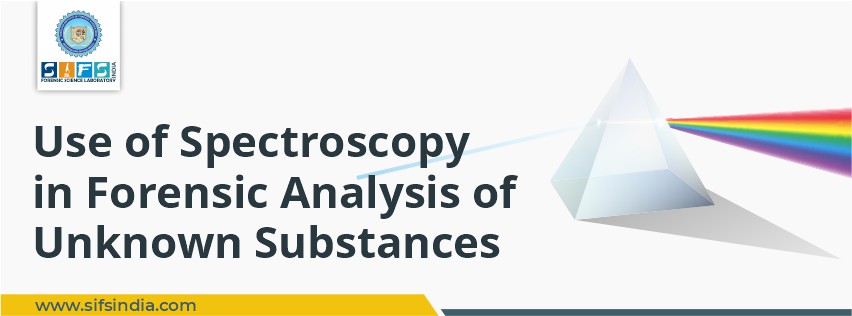Forensic science is a field where we study how a crime took place and how we can identify and find the evidence to trace the culprit so that can be punished in order to maintain the society as a good and healthy place.
For that we need to identify how to collect evidence identify it to suspect list and we have to know about that substance so here a modern scientific tool spectroscopy comes in action as depending on different wavelength of electromagnetic waves as it helps the forensic expert to withdraw his conclusion.
What is Spectroscopy?
The branch of science where we study about the measurement of spectra produced when matter interacts with or emits with electromagnetic radiation.
It happens as when electromagnetic waves are bombarded on the sample and the sample on interaction with the electromagnetic wave either absorb it or emit it and further the electromagnetic waves travels to detector.
Now, we can note that every molecule absorb different energy of electromagnetic radiation which correspond it to different spectra range according to the energy it absorbed.
As these electromagnetic waves are absorbed by samples in form of photons we know that it is quantized and thus can corresponds to a particular wavelength.
Matter and Different Types of Bonds
As every substance is made of atoms and molecules we know that in a molecule there is different bond which has different energies .
As a molecule have electrons in its valence shell, it can form covalent or ionic bond depending upon sharing or donating electrons moreover we can see formation of pi bond which corresponds to different energy and moreover we can see different orientation of electrons which is continuously moving in either clockwise or anti clockwise direction which also have different energies so this all can form , break or react to different energies
We also know that a molecule is always in a rotational motion as well as translational motion so providing different energies it all can be affected .
Interaction Between Electromagnetic Waves and Matter
When electromagnetic waves are bombarded on the matter ,different bonds absorb different energy from the em spectrum and corresponds to different spectrums.
As spectrum of electromagnetic waves in order of increasing wavelength and decreasing energies is:
Gamma rays> Xrays> UV rays> Visible range> IR rays> microwaves> radio waves.
Gamma rays are most powerful rays and penetrate and has a destructive effect and it changes conformational and structure of an element.
Radio waves have least energy and cause least damage they have high wavelength thus used in radio signaling.
All spectra’s lie between these ranges corresponding to the energy it observed.
UV/Visible Spectroscopy
Generally, there is shift of electrons in orbitals due to energy difference between ground and excite state in UV/visible spectroscopy.
Spectrum is few in number (its due to limited number of valence electrons) and is quite broad in shape which is dependent on temperature.
Broadness of spectrum is directly proportional to temperature.
Light source emitting the lights are Deuterium and indascent lamp in UV and visible range respectively.
Sample is holded by cuvette which is methyl alcohol and em waves are transferred from source to sample holder which do not absorb UV/visible range and then em waves reaches detector and spectra is created.
Infrared Spectroscopy
Each molecules have different vibrations within molecules in this technique spectra is made so purity and identification is done.
In this method Kbr is used as pellet which is in a powder form and under high pressure changes in a solid this does not absorb infrared radiation.
A solution of x% is mixed in this Kbr pellet and under infrared radiation this can be easily identify as only sample absorb infrared radiation.
This technique is quite useful in identification of petroleum products and other organic compounds as each functional group has its own vibrational energy.
Mass Spectrometry
In this technique element identification is based on mass/charge ratio. Its very sensitive technique. Its often use as detectors in gas chromatography or HPLC.
In this a sample is introduced either by gas/liquid chromatography, ICPMS, electrospray or by direct injection.
Then its loaded in vaccum region where it is ionized by electron impact, chemical ionization and laser desorption method.
Then ions are separated by ion trap method , magnetic sector , quadrapole and time of flight method
Finally its detected by electron multiplier which is used as detector in mass spectrometer.
Conclusion
Different spectra are obtained based on the absorbance of electromagnetic waves by the sample can help us to observe and identify the substances and help us in tracing the element from the crime scene and narrow down the further search for the person who committed the crime.

 October 17, 2023 - BY SIFS India
October 17, 2023 - BY SIFS India